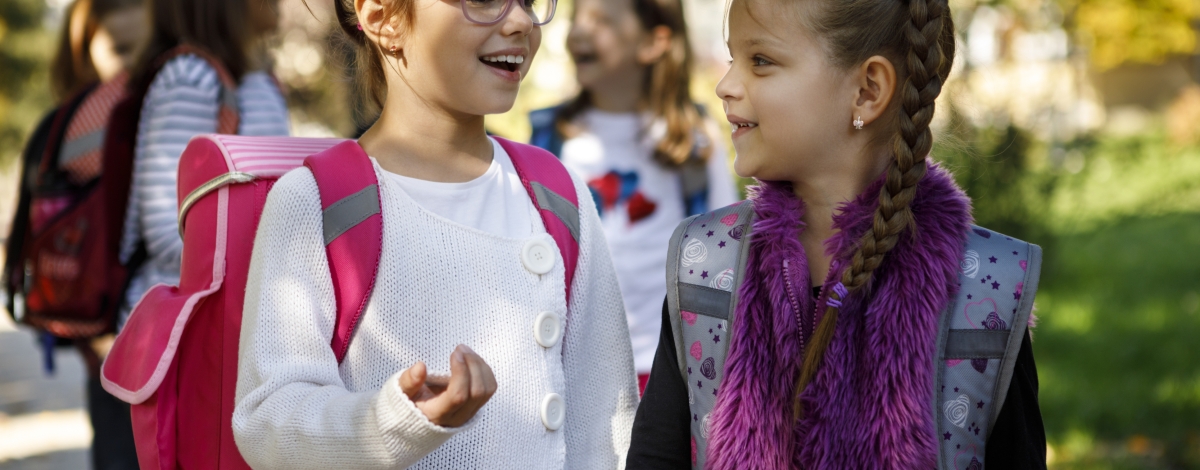Making New Friends This School Year
If you ask parents what they wish for their child, the answer is usually “to make friends in school.” Making friends is an important part of childhood, but that doesn’t necessarily mean it’s easy. Children are not born with social skills, so parents need to prepare them to interact successfully with other kids.
“It’s important for your child to know the difference between a friend and the acquaintance of another classmate, especially if he or she is struggling to make friends. Explaining that some friends we just say “hello” to in the halls, and other friends we tell really personal information and some we are just getting know and are deciding how close they can be to us, helps a child discern the different types of friendship,” says Marlies Gramann, Associate Vice President of Disability Services at JCFS Chicago.
Children’s social needs and skills change as they grow. Their ideas about what friendship actually is also changes as they develop. According to psychologist Robert Selman, there are five stages that children go through as they learn to make and keep friends. This framework helps families understand developmental trends in children’s friendships. (Described below by Eileen Kennedy-Moore Ph.D., in Psychology Today)
LEVEL 0 Friendship—Momentary Playmates: "I Want It My Way"
(Approximate ages: 3-6 years)
Children at this stage view friends as momentary playmates, and their friendships are all about having fun together. Their friends are kids who are conveniently nearby, and who do the same things they like to do.
Children at this stage have very limited ability to see other perspectives. They assume that other children think the same way they do, so they tend to get very upset when they find out that a playmate has a different opinion.
Children in the "I Want It My Way" stage like the idea of having friends, and they definitely have preferences for some peers over others, but they're not so good at being reliable friends. For instance, three-year-olds might say, "You're not my friend today!" if they just feel like doing something other than what their friend wants to do.
LEVEL 1 Friendship—One-Way Assistance: "What's In It For Me?"
(Approximate ages: 5-9 years)
At this level, children understand that friendship goes beyond whatever their current activity is, but they still think in very pragmatic terms. They define friends as children who do nice things for them—such as sharing a treat, saving them a seat on the bus, or giving them nice presents—but they don't really think about what they themselves contribute to the friendship.
Children at this level care a lot about friendship. They may even put up with a not-so-nice friend, just so they can have a friend. They also may try to use friendship as a bargaining chip, saying things like "I'll be your friend if you do this!" or "I won't be your friend if you do that!"
LEVEL 2 Friendship—Two-Way, Fair Weather Cooperation: "By the Rules"
(Approximate ages: 7-12 years)
Seven- to twelve-year-old children are able to consider a friend's perspective in addition to their own, but not at the same time. So what this means is that they understand turn taking, but they can't really step back and get an observer's perspective that would allow them to see patterns of interaction in their relationships.
At this stage, children are very concerned about fairness and reciprocity, but they think about these in a very rigid, quid pro quo way. So, if they do something nice for a friend, they expect that friend to do something nice for them at the next opportunity. If this doesn't happen, the friendship is likely to fall apart.
Children in the "By the Rules" stage tend to be very judgmental of both themselves and others. They evaluate themselves harshly, the way they think other people do. So, they say things like, "No one will like me because of my stupid haircut!" They tend to be jealous, and they're very concerned with fitting in by being exactly the same as everyone else.
Children at this stage often invent "secret clubs." These involve elaborate rules and lots of discussion about who is or isn't included as a member, but they tend to be short-lived.
LEVEL 3 Friendship—Intimate, Mutually Shared Relationships: "Caring and Sharing"
(Approximate ages: 8-15 years)
At this stage, friends help each other solve problems and confide thoughts and feelings that they don't share with anyone else. They know how to compromise, and they do kind things for each other without "keeping score," because they genuinely care about each other's happiness.
For some children, this is also the "Joined at the Hip" stage. Girls, more often than boys, may be best friends and expect each other to do everything together. They feel deeply betrayed if a best friend chooses to be with another child.
LEVEL 4 Friendship—Mature Friendship: "Friends Through Thick and Thin"
(Approximate ages: 12 years and up)
At this stage, children place a high value on emotional closeness with friends. They can accept and even appreciate differences between themselves and their friends. They're also not as possessive, so they're less likely to feel threatened if their friends have other relationships. Mature friendship emphasizes trust and support and remaining close over time, despite separations.
Friendships take time, and for some children it can take longer to connect with their peers. “Role-playing is a great way to enhance your child’s friendship and social skills,” states Marlies, “It can help him or her develop the basic trust and self-confidence necessary to bond with other classmates.”
JCFS Chicago provides occupational and speech/language therapies and social skills development for children from birth through adolescence. We evaluate social, emotional and developmental delays using specialized assessments to bring a family-focused approach to your child’s treatment. For more information contact 847.412.4379 or ipi@jcfs.org.



 Back
Back